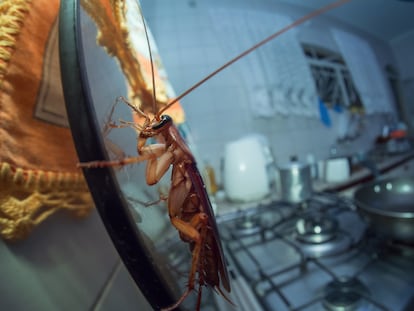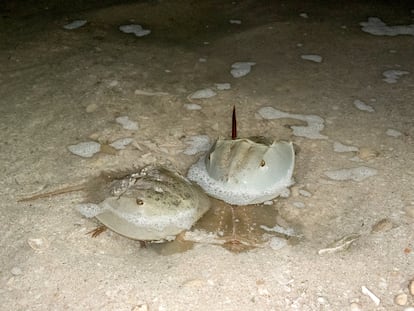The origin of cockroaches: From the fields of India to your kitchen
A new genetic study has traced the origins of the German cockroach, which accounts for most of the world’s pests and lives exclusively in urban environments

Most cockroaches don’t bother humans. They have existed in the Earth’s diverse ecosystems for 130 million years, helping to recycle the organic matter on which they feed. Today, there are approximately 4,000 species and fewer than 1% live among us. Among these only one, the German cockroach (Blattella germanica), accounts for most of the world’s pests. Now, at last, science has traced its history.
It turns out that the German cockroach lives exclusively in urban environments; there is no population in the wild. So where do they come from? Despite its name, it has never been believed to have come from Europe, as the region has no other species of the genus Blattella.
The first historical record of this animal in Europe is from around the time of the Seven Years’ War (1756-1763). The common names given to it varied according to the side: the Russians called it the “Prussian cockroach” and their opponents the “Russian cockroach.” Eventually, in 1767, Swedish biologist Carl Linnaeus collected some specimens in Germany and named it Blattella germanica, but he really did not know its origin.
It was believed that this cockroach might have come from Africa, until 1950, when scientists from Harvard University made an expedition to India and discovered another strikingly similar cockroach. The hypothesis that it came from Asia became the most widely accepted, but how it came to spread around the world remained a mystery. Until now.
A group of scientists has taken DNA samples from these arthropods in 17 countries and compared their sequences. The results, recently published in the journal PNAS, have allowed them to trace the journey of the German cockroach from its place of origin to our homes.
The sequence of the German cockroach was almost identical to that of Blattella asahinai, a cockroach from the Bay of Bengal. This means that these two species diverged relatively recently — 2,100 years ago — probably when Indian farmers left the countryside and moved to cities.
It first left India 1,200 years ago and headed westward, but did not get too far. Later there was another wave that reached Indonesia and just 270 years ago they reached Europe, which is consistent with accounts from the Seven Years’ War. Finally, they colonized the rest of the world, 120 years ago.
There is an explanation as to why the German cockroach started traveling so recently: the species is characterized by a very short life expectancy, which means that, in order to distribute itself around the world, it requires short transportation times. As human technology progressed, transportation became faster and travel times shorter. It is therefore unsurprising that the greatest expansion of cockroach distribution occurred in the 20th century.
This is how the authors of the study explain it in The Conversation: “We believe global trade facilitated this spread because more closely related populations are found in countries with cultural links, rather than countries that are simply close to one another.”
In addition, the German cockroach is a tropical species that has an optimum temperature of between 25ºC and 32ºC (77ºF and 90°F). As human technology improved indoor conditions such as heating and building insulation, the cockroach was able to expand its range to temperate zones. The heat from mechanical and electric motors in elevators, escalators, and generators also helped.
It is striking that, with the two species of cockroaches being so similar, one has remained in the fields of India and the other has become fully urbanized to follow humans around the globe. What aspects of an animal can trigger such a change in lifestyle?
High reproductive rate and more gregarious
In addition to being short-lived, the German cockroach is characterized by its smaller size, which allows it to maintain a larger population when resources are limited. This translates into more cockroaches in less time, which increases the rate of evolution and thus the ability to adapt. German cockroaches were able to quickly adapt to new environmental circumstances, such as new building materials, new types of food, and other human factors. They also developed resistance to insecticides easily.
But the main difference between Blattella germanica and Blattella asahinai is that the German cockroach is gregarious, which allows more individuals to survive in small shelters inside human dwellings. This is very important. If we think about it, most animal species that are considered pests in cities are characterized by being very social, such as rats.
The German cockroach shows the most advanced social organization among all cockroach species that can be considered a pest. When isolated outside their group, German cockroaches suffer from “isolation syndrome.” Symptoms include delayed sexual maturation and various behavioral disturbances, such as reduced foraging and less demanding evaluation of potential breeding partners.
In addition, when isolated, they reduce the amounts of hydrocarbons they reveal in their cuticle. These molecules are responsible for regulating their social behavior, allowing them to recognize each other among related cockroaches and to decide with whom they will mate. In contrast, other cockroach species do not display these symptoms.
Therefore, we have a cockroach species that, due to its high reproduction rate and its gregarious behavior, has managed to adapt perfectly to life in the city. The comfort we create in our homes also provides creature comforts for Blattella germanica and, currently, there is no insecticide capable of killing an animal that adapts so easily. In all likelihood, as long as there are humans on Earth, the German cockroach will remain among us.
Sign up for our weekly newsletter to get more English-language news coverage from EL PAÍS USA Edition
Tu suscripción se está usando en otro dispositivo
¿Quieres añadir otro usuario a tu suscripción?
Si continúas leyendo en este dispositivo, no se podrá leer en el otro.
FlechaTu suscripción se está usando en otro dispositivo y solo puedes acceder a EL PAÍS desde un dispositivo a la vez.
Si quieres compartir tu cuenta, cambia tu suscripción a la modalidad Premium, así podrás añadir otro usuario. Cada uno accederá con su propia cuenta de email, lo que os permitirá personalizar vuestra experiencia en EL PAÍS.
¿Tienes una suscripción de empresa? Accede aquí para contratar más cuentas.
En el caso de no saber quién está usando tu cuenta, te recomendamos cambiar tu contraseña aquí.
Si decides continuar compartiendo tu cuenta, este mensaje se mostrará en tu dispositivo y en el de la otra persona que está usando tu cuenta de forma indefinida, afectando a tu experiencia de lectura. Puedes consultar aquí los términos y condiciones de la suscripción digital.
More information
Archived In
Últimas noticias
Most viewed
- Reinhard Genzel, Nobel laureate in physics: ‘One-minute videos will never give you the truth’
- Oona Chaplin: ‘I told James Cameron that I was living in a treehouse and starting a permaculture project with a friend’
- Pablo Escobar’s hippos: A serious environmental problem, 40 years on
- Charles Dubouloz, mountaineering star, retires at 36 with a farewell tour inspired by Walter Bonatti
- Why we lost the habit of sleeping in two segments and how that changed our sense of time










































